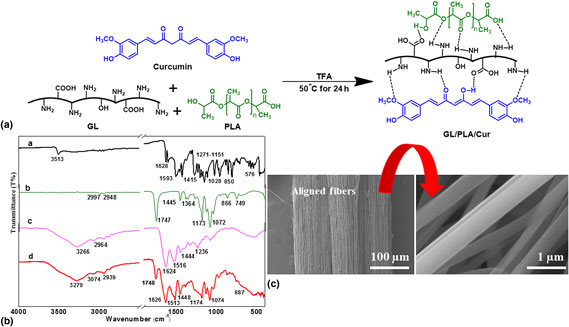Crossref Citations
This article has been cited by the following publications. This list is generated based on data provided by
Crossref.
Chiaoprakobkij, Nadda
Suwanmajo, Thapanar
Sanchavanakit, Neeracha
and
Phisalaphong, Muenduen
2020.
Curcumin-Loaded Bacterial Cellulose/Alginate/Gelatin as A Multifunctional Biopolymer Composite Film.
Molecules,
Vol. 25,
Issue. 17,
p.
3800.
Mamidi, Narsimha
Velasco Delgadillo, Ramiro
Gonzáles Ortiz, Aldo
and
Barrera, Enrique
2020.
Carbon Nano-Onions Reinforced Multilayered Thin Film System for Stimuli-Responsive Drug Release.
Pharmaceutics,
Vol. 12,
Issue. 12,
p.
1208.
Rojas, Adrián
Velásquez, Eliezer
Garrido, Luan
Galotto, María José
and
López de Dicastillo, Carol
2020.
Design of active electrospun mats with single and core-shell structures to achieve different curcumin release kinetics.
Journal of Food Engineering,
Vol. 273,
Issue. ,
p.
109900.
Bonadies, Irene
Di Cristo, Francesca
Valentino, Anna
Peluso, Gianfranco
Calarco, Anna
and
Di Salle, Anna
2020.
pH-Responsive Resveratrol-Loaded Electrospun Membranes for the Prevention of Implant-Associated Infections.
Nanomaterials,
Vol. 10,
Issue. 6,
p.
1175.
Mamidi, Narsimha
Delgadillo, Ramiro Manuel Velasco
and
Castrejón, Javier Villela
2021.
Unconventional and facile production of a stimuli-responsive multifunctional system for simultaneous drug delivery and environmental remediation.
Environmental Science: Nano,
Vol. 8,
Issue. 7,
p.
2081.
Sharma, Deepika
and
Satapathy, Bhabani K.
2021.
Understanding release kinetics and collapse proof suture retention response of curcumin loaded electrospun mats based on aliphatic polyesters and their blends.
Journal of the Mechanical Behavior of Biomedical Materials,
Vol. 120,
Issue. ,
p.
104556.
Chagas, Paulo A.M.
Schneider, Rodrigo
dos Santos, Danilo M.
Otuka, Adriano J.G.
Mendonça, Cleber R.
and
Correa, Daniel S.
2021.
Bilayered electrospun membranes composed of poly(lactic-acid)/natural rubber: A strategy against curcumin photodegradation for wound dressing application.
Reactive and Functional Polymers,
Vol. 163,
Issue. ,
p.
104889.
Jee Kanu, Nand
Gupta, Eva
Sutar, Venkateshwara
Kumar Singh, Gyanendra
and
Kumar Vates, Umesh
2021.
Nanofibers - Synthesis, Properties and Applications.
Mamidi, Narsimha
Delgadillo, Ramiro Manuel Velasco
and
González-Ortiz, Aldo
2021.
Engineering of carbon nano-onion bioconjugates for biomedical applications.
Materials Science and Engineering: C,
Vol. 120,
Issue. ,
p.
111698.
Ma, Lulu
Liu, Feng
Liu, Dongyu
and
Liu, Yaolu
2021.
Review of Strain Rate Effects of Fiber-Reinforced Polymer Composites.
Polymers,
Vol. 13,
Issue. 17,
p.
2839.
Olkhov, Anatoliy
Alexeeva, Olga
Konstantinova, Marina
Podmasterev, Vyacheslav
Tyubaeva, Polina
Borunova, Anna
Siracusa, Valentina
and
Iordanskii, Alex L.
2021.
Effect of Glycero-(9,10-trioxolane)-trialeate on the Physicochemical Properties of Non-Woven Polylactic Acid Fiber Materials.
Polymers,
Vol. 13,
Issue. 15,
p.
2517.
Sharma, Deepika
and
Satapathy, Bhabani K.
2021.
Optimally controlled morphology and physico-mechanical properties of inclusion complex loaded electrospun polyvinyl alcohol based nanofibrous mats for therapeutic applications.
Journal of Biomaterials Science, Polymer Edition,
Vol. 32,
Issue. 9,
p.
1182.
Peranidze, Kristina
Safronova, Tatiana V.
and
Kildeeva, Nataliya R.
2021.
Fibrous Polymer-Based Composites Obtained by Electrospinning for Bone Tissue Engineering.
Polymers,
Vol. 14,
Issue. 1,
p.
96.
Mitra, Souradeep
Mateti, Tarun
Ramakrishna, Seeram
and
Laha, Anindita
2022.
A Review on Curcumin-Loaded Electrospun Nanofibers and their Application in Modern Medicine.
JOM,
Vol. 74,
Issue. 9,
p.
3392.
García-Valderrama, Elsy J.
Mamidi, Narsimha
Antunes-Ricardo, Marilena
Gutiérrez-Uribe, Janet A.
Del Angel-Sanchez, Karina
and
Elías-Zúñiga, Alex
2022.
Engineering and Evaluation of Forcespun Gelatin Nanofibers as an Isorhamnetin Glycosides Delivery System.
Pharmaceutics,
Vol. 14,
Issue. 6,
p.
1116.
Wasim, Muhammad
Shi, Fei
Liu, Jingxiao
Zhang, Haoyuan
Zhu, Keya
and
Tian, Ziwei
2022.
Synthesis and characterization of curcumin/MMT-clay-treated bacterial cellulose as an antistatic and ultraviolet-resistive bioscaffold.
Journal of Polymer Research,
Vol. 29,
Issue. 10,
Mamidi, Narsimha
García, Rubén Gutiérrez
Martínez, José Daniel Hernández
Briones, Camila Martínez
Martínez Ramos, Andrea Michelle
Tamez, María Fernanda Leal
Del Valle, Braulio González
and
Segura, Francisco Javier Macias
2022.
Recent Advances in Designing Fibrous Biomaterials for the Domain of Biomedical, Clinical, and Environmental Applications.
ACS Biomaterials Science & Engineering,
Vol. 8,
Issue. 9,
p.
3690.
Lopez Marquez, Alex
Gareis, Iván Emilio
Dias, Fernando José
Gerhard, Christoph
and
Lezcano, María Florencia
2022.
How Fiber Surface Topography Affects Interactions between Cells and Electrospun Scaffolds: A Systematic Review.
Polymers,
Vol. 14,
Issue. 1,
p.
209.
Zheng, Yanzhao
Yao, Fei
and
Chen, Fusheng
2022.
Curcumin-loaded electrospun peanut protein isolate/ poly-l-lactic acid nanofibre membranes: Preparation and characterisation and release behaviour.
LWT,
Vol. 169,
Issue. ,
p.
113978.
Lopez Marquez, Alex
Gareis, Iván Emilio
Dias, Fernando José
Gerhard, Christoph
and
Lezcano, María Florencia
2022.
Methods to Characterize Electrospun Scaffold Morphology: A Critical Review.
Polymers,
Vol. 14,
Issue. 3,
p.
467.





